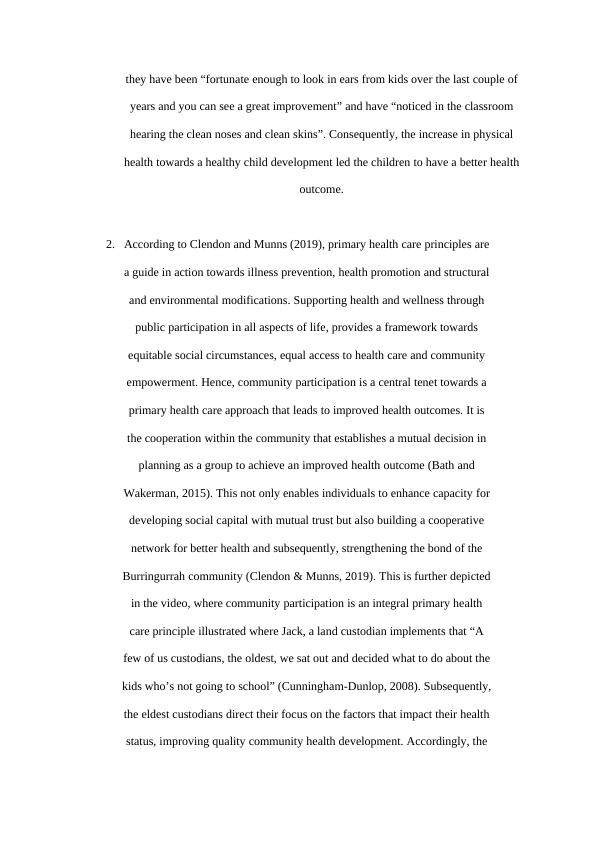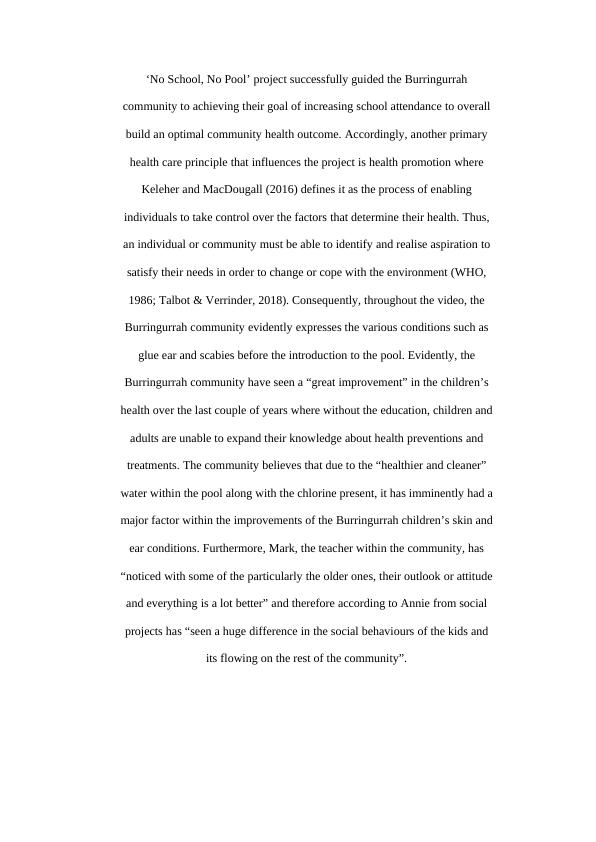Ask a question from expert
Social Determinants of Health- PDF
8 Pages2130 Words111 Views
Added on 2021-08-16
Social Determinants of Health- PDF
Added on 2021-08-16
BookmarkShareRelated Documents
1. Social determinants of health (SDH) according to Foster et al. (2021), are non-
medical factors that influence health outcomes. The conditions in which people are
born, grow and work evidently shape the conditions of the individual’s daily life.
The World Health Organisation (WHO) has formally recognised that there are a
total of 10 social determinants of health that affect an individual’s ability to adopt a
healthy lifestyle (WHO, 1986). Education and a healthy child development,
components to the social determinants of health are evidently portrayed within the
‘No School, No Pool’ project video. Rochelle, a parent within the Burringurrah
community, located in the remote North Western Australia, has stated that “since
the pools have been up and they made the rule ‘No School, No Pool’ there’s more
attendance at the school” (Cunningham-Dunlop, 2008). Hence, the rule provides an
incentive for children, increasing the number of children attending school and thus,
receiving education. Hart et al (2017) elucidates that education plays a crucial
factor in conjunction with an individual’s health status, delineating that educational
programs provide an increase in knowledge of health and ways to access it and
thus, improving health outcomes. This is evidently analysed in the video,
communicating the value of education within the Burringurrah community where
the eldest custodians provide incentives for the children to receive an education.
According to Brady et al (2020), healthy child development is imminently a vital
social determinant of health, having a substantial role within shaping an
individual’s outcome with their future health. In reference to the video, the
Burringurrah community stated that before the introduction of the community pool,
the Burringurrah children were prone to various diseases and infections such as
scabies and glue ear. Evidently, the community started to see changes after less
than six months after the introduction of the pool where Mark, the teacher mentions
medical factors that influence health outcomes. The conditions in which people are
born, grow and work evidently shape the conditions of the individual’s daily life.
The World Health Organisation (WHO) has formally recognised that there are a
total of 10 social determinants of health that affect an individual’s ability to adopt a
healthy lifestyle (WHO, 1986). Education and a healthy child development,
components to the social determinants of health are evidently portrayed within the
‘No School, No Pool’ project video. Rochelle, a parent within the Burringurrah
community, located in the remote North Western Australia, has stated that “since
the pools have been up and they made the rule ‘No School, No Pool’ there’s more
attendance at the school” (Cunningham-Dunlop, 2008). Hence, the rule provides an
incentive for children, increasing the number of children attending school and thus,
receiving education. Hart et al (2017) elucidates that education plays a crucial
factor in conjunction with an individual’s health status, delineating that educational
programs provide an increase in knowledge of health and ways to access it and
thus, improving health outcomes. This is evidently analysed in the video,
communicating the value of education within the Burringurrah community where
the eldest custodians provide incentives for the children to receive an education.
According to Brady et al (2020), healthy child development is imminently a vital
social determinant of health, having a substantial role within shaping an
individual’s outcome with their future health. In reference to the video, the
Burringurrah community stated that before the introduction of the community pool,
the Burringurrah children were prone to various diseases and infections such as
scabies and glue ear. Evidently, the community started to see changes after less
than six months after the introduction of the pool where Mark, the teacher mentions

they have been “fortunate enough to look in ears from kids over the last couple of
years and you can see a great improvement” and have “noticed in the classroom
hearing the clean noses and clean skins”. Consequently, the increase in physical
health towards a healthy child development led the children to have a better health
outcome.
2. According to Clendon and Munns (2019), primary health care principles are
a guide in action towards illness prevention, health promotion and structural
and environmental modifications. Supporting health and wellness through
public participation in all aspects of life, provides a framework towards
equitable social circumstances, equal access to health care and community
empowerment. Hence, community participation is a central tenet towards a
primary health care approach that leads to improved health outcomes. It is
the cooperation within the community that establishes a mutual decision in
planning as a group to achieve an improved health outcome (Bath and
Wakerman, 2015). This not only enables individuals to enhance capacity for
developing social capital with mutual trust but also building a cooperative
network for better health and subsequently, strengthening the bond of the
Burringurrah community (Clendon & Munns, 2019). This is further depicted
in the video, where community participation is an integral primary health
care principle illustrated where Jack, a land custodian implements that “A
few of us custodians, the oldest, we sat out and decided what to do about the
kids who’s not going to school” (Cunningham-Dunlop, 2008). Subsequently,
the eldest custodians direct their focus on the factors that impact their health
status, improving quality community health development. Accordingly, the
years and you can see a great improvement” and have “noticed in the classroom
hearing the clean noses and clean skins”. Consequently, the increase in physical
health towards a healthy child development led the children to have a better health
outcome.
2. According to Clendon and Munns (2019), primary health care principles are
a guide in action towards illness prevention, health promotion and structural
and environmental modifications. Supporting health and wellness through
public participation in all aspects of life, provides a framework towards
equitable social circumstances, equal access to health care and community
empowerment. Hence, community participation is a central tenet towards a
primary health care approach that leads to improved health outcomes. It is
the cooperation within the community that establishes a mutual decision in
planning as a group to achieve an improved health outcome (Bath and
Wakerman, 2015). This not only enables individuals to enhance capacity for
developing social capital with mutual trust but also building a cooperative
network for better health and subsequently, strengthening the bond of the
Burringurrah community (Clendon & Munns, 2019). This is further depicted
in the video, where community participation is an integral primary health
care principle illustrated where Jack, a land custodian implements that “A
few of us custodians, the oldest, we sat out and decided what to do about the
kids who’s not going to school” (Cunningham-Dunlop, 2008). Subsequently,
the eldest custodians direct their focus on the factors that impact their health
status, improving quality community health development. Accordingly, the

‘No School, No Pool’ project successfully guided the Burringurrah
community to achieving their goal of increasing school attendance to overall
build an optimal community health outcome. Accordingly, another primary
health care principle that influences the project is health promotion where
Keleher and MacDougall (2016) defines it as the process of enabling
individuals to take control over the factors that determine their health. Thus,
an individual or community must be able to identify and realise aspiration to
satisfy their needs in order to change or cope with the environment (WHO,
1986; Talbot & Verrinder, 2018). Consequently, throughout the video, the
Burringurrah community evidently expresses the various conditions such as
glue ear and scabies before the introduction to the pool. Evidently, the
Burringurrah community have seen a “great improvement” in the children’s
health over the last couple of years where without the education, children and
adults are unable to expand their knowledge about health preventions and
treatments. The community believes that due to the “healthier and cleaner”
water within the pool along with the chlorine present, it has imminently had a
major factor within the improvements of the Burringurrah children’s skin and
ear conditions. Furthermore, Mark, the teacher within the community, has
“noticed with some of the particularly the older ones, their outlook or attitude
and everything is a lot better” and therefore according to Annie from social
projects has “seen a huge difference in the social behaviours of the kids and
its flowing on the rest of the community”.
community to achieving their goal of increasing school attendance to overall
build an optimal community health outcome. Accordingly, another primary
health care principle that influences the project is health promotion where
Keleher and MacDougall (2016) defines it as the process of enabling
individuals to take control over the factors that determine their health. Thus,
an individual or community must be able to identify and realise aspiration to
satisfy their needs in order to change or cope with the environment (WHO,
1986; Talbot & Verrinder, 2018). Consequently, throughout the video, the
Burringurrah community evidently expresses the various conditions such as
glue ear and scabies before the introduction to the pool. Evidently, the
Burringurrah community have seen a “great improvement” in the children’s
health over the last couple of years where without the education, children and
adults are unable to expand their knowledge about health preventions and
treatments. The community believes that due to the “healthier and cleaner”
water within the pool along with the chlorine present, it has imminently had a
major factor within the improvements of the Burringurrah children’s skin and
ear conditions. Furthermore, Mark, the teacher within the community, has
“noticed with some of the particularly the older ones, their outlook or attitude
and everything is a lot better” and therefore according to Annie from social
projects has “seen a huge difference in the social behaviours of the kids and
its flowing on the rest of the community”.

End of preview
Want to access all the pages? Upload your documents or become a member.
Related Documents
(PDF) Social determinants of healthlg...
|11
|2359
|245
Primary Health Care in Actionlg...
|10
|2358
|207
Healthy child development - Assignment PDFlg...
|9
|2193
|182
Healthy child development Assignment PDFlg...
|9
|2238
|280
Social Determinants of Health (SDOH)lg...
|9
|2000
|74
Primary Healthcare in Actionlg...
|9
|2054
|70